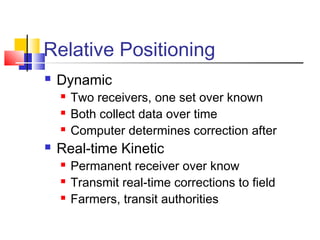Global positioning system
- 1. Global Positioning System (GPS) Satellite Location 20 Satellites in system Each carries very accurate clock Sends a coded signal every millisecond Ground Stations Track satellite locations Send signals to satellites to correct errors
- 2. Local Receivers Generate same signals as satellite Compare differences to determine distance to satellite Clocks not nearly as accurate Some errors occur
- 3. GPS Location Location found by comparing signals Time Difference x Light Speed = Distance Clocks accurate to nanosecond (1 x 10-9 s) Accuracy = (186,282 mi/s)(5280 ft/mi)(1 x 10-9 s) = 0.984 ft How do we locate to the cm?
- 4. Multiple Satellites One – distance only Two – point falls on a circle Three – one of two points 4 or more – average to eliminate error
- 5. Who Uses GPS? Surveyors Military Agriculture Railroads Corporate fleets Auto Security
- 6. Where Are We? Longitude Starts at Greenwich 180° E or W Longitude Starts at Equator 90° N or S Moorhead N 46°52’ Latitude, W 96°45’ Longitude
- 7. Convert to Grid Projections Lambert’s Conformal Transverse Mercator GPS uses UTM Error limited to 1:10,000 Computer models convert Lat, Long to universal grid
- 8. Sources of Error Atmospheric Built-in Compensation Receivers More satellites, better averaging Selective Availability Intentional Error – DOD Same error at any given time Eliminate by differential positioning
- 9. Relative Positioning Dynamic Two receivers, one set over known Both collect data over time Computer determines correction after Real-time Kinetic Permanent receiver over know Transmit real-time corrections to field Farmers, transit authorities
- 10. PDOP Position Dilution of Precision Numeric scale indicating precision Depends on position, number of satellites Satellite alignment could limit precision PDOP = 1: Best precision PDOP = 5: Very poor – try later










